You might’ve heard of the Sony PlayStation. What was originally planned as a collaboration between Nintendo & Sony to expand the Super Nintendo Entertainment System with a CD drive, became something completely different with Sony forging their own path after Nintendo reneged on their deal.
While the console’s legacy speaks for itself, spawning record breaking successors and some of the most popular game franchises of all time, the impact of that original controller design can’t be overstated. The simple geometric shapes of a blue cross, red circle, green triangle and pink square, now commonly referred to as the sacred symbols, have been synonymous with the brand and have been on every controller (and handheld) since. They’ve officially entered pop culture and you can even pick up merchandise adorned with this ubiquitous iconography. The PlayStation controller is something that multiple generations have grown up with. Whether you know it or not, there’s a lot of muscle memory built around these hunks of plastic.
At time of writing, the PlayStation 5 has already been released in America with the DualSense controller, which has received overwhelming positive acclaim. Before we appreciate the new controller, let’s take a look at Sony’s past and how the DualSense came to be.
PlayStation Controller
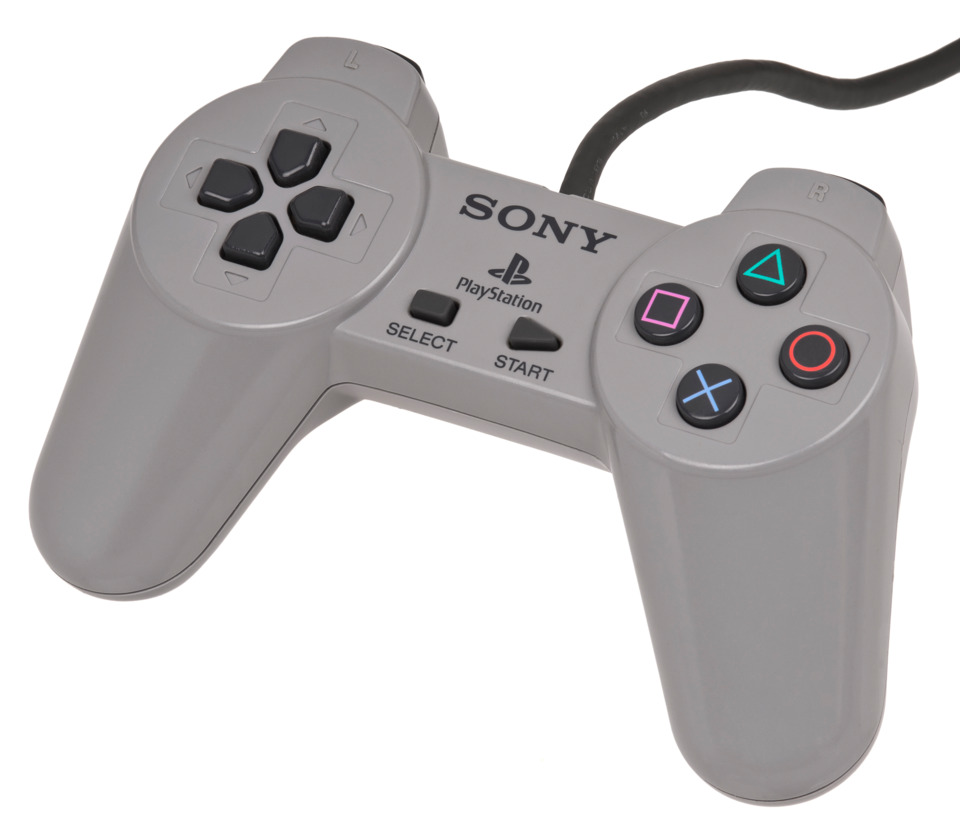
Before the term DualShock was even uttered there was simply the “PlayStation Controller”, initially released December 3, 1994 packaged with the original PlayStation (now referred to as the PSX).
This was the first time consumers had seen the influential “sacred symbols”, instead of the traditional letters that had been used by console manufacturers before. This was not coincidental however; Teiyu Goto, designer of the original PlayStation controller, explained that the Circle means ‘yes’, the Cross means ‘no’, Triangle symbolises a point of view and Square is equated to a sheet of paper, in other words, used to access menus. While this philosophy was followed in Japan, it was different in the west – Circle and Cross were mostly reversed, and sometimes even Triangle was used to mean ‘no’, due to its placement on the controller presumably.
The button configuration borrowed liberally from Nintendo’s SNES, but Sony added a second pair of shoulder buttons for the middle fingers aptly named L2 and R2 to compliment the L1 and R1 buttons. The intention for these extra buttons was to help the user navigate between 3D environments which had hardly been seen before. With the addition of extra shoulder buttons Sony found a flat controller like the design of Nintendo’s SNES would be pretty uncomfortable. Sony released that they needed to add a bit of chunk to their design for it to be comfortable. Enter the grip handles, added to the bottom half of the controller. Another design choice was instead of a traditional D-Pad that Nintendo and Sega typically designed, it utilised four directional buttons.
Former chairman and CEO of Sony Computer Entertainment Ken Kutaragi stated:
“In development, we simulated every possible joypad situation. We imagined what it would be like to have to continually put the pad down while mapping a game, or playing while lying on the floor, and many other cases. After that we had to decide on the weight of the buttons and the pad itself. We adjusted the weights one gram at a time and eventually we found the correct balance. We probably spent as much time on the joypad’s development as we did on the body of the machine.”
From its initial conception, Sony knew they had to create something unique – it had to be ergonomic so it would fit well in the players hand, and it’s design had to be unmistakable. It’s safe to say years later that they accomplished their mission.
It did not end with the initial release however, it adapted over time. The North American model of the Playstation controller was produced to be around 10% larger than the Japanese model, because everything is bigger in America! (Even the hands).
A minor revision of the controller was released on April 2, 1996. Although identical to its predecessor, this version has a longer lead and noise filter near the socket. Ever wondered what the weird weight thing was next to the controller plug? Well, now you know!

Dual Analog Controller
Before the now famous DualShock, Sony created a controller without any fancy branding, releasing what we call the “Dual Analog Controller”. In terms of new features, the controller adds one vibration motor and two analog sticks (called L3 and R3 when pressed respectively). You may also see the ‘Analog’ button, which has three functions; Digital, Analog and an Analog Flightstick mode. Digital disables the new L3 and R3 sticks, Analog, as the name may imply, allows you to use the new analog sticks, and Analog Flightstick allows you to emulate that of the Flightstick that was released for the PlayStation, which only all of the cool kids had.
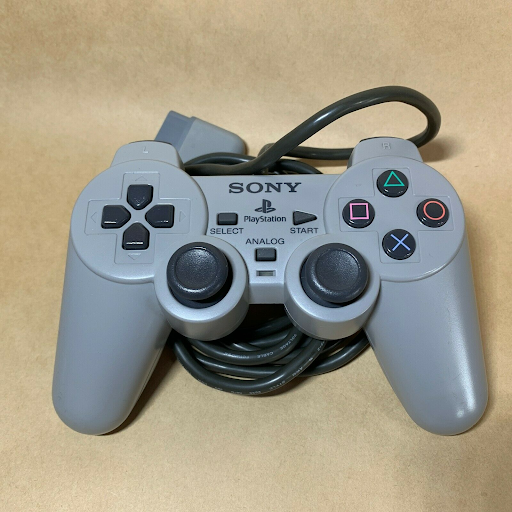
Considered the strange distant cousin of the original PlayStation controller and the DualShock, it was released on April 25, 1997 in Japan, United States on August 27, 1997, and in Europe in September 1997. The controller is believed to be better than the DualShock by some due to its longer grips, but it never really caught on with the arrival of the DualShock just a few months later.
DualShock Analog Controller
Released on November 20, 1997 The DualShock’s name comes from the dual (two) vibration motors placed within the handles of the controller, and feature two different sized motors to allow for varying degrees of vibration. The purpose? To give you more feedback while playing to immerse you even further than before (the Dual Analog Controller only had one motor, as did the N64 Rumble Pak).
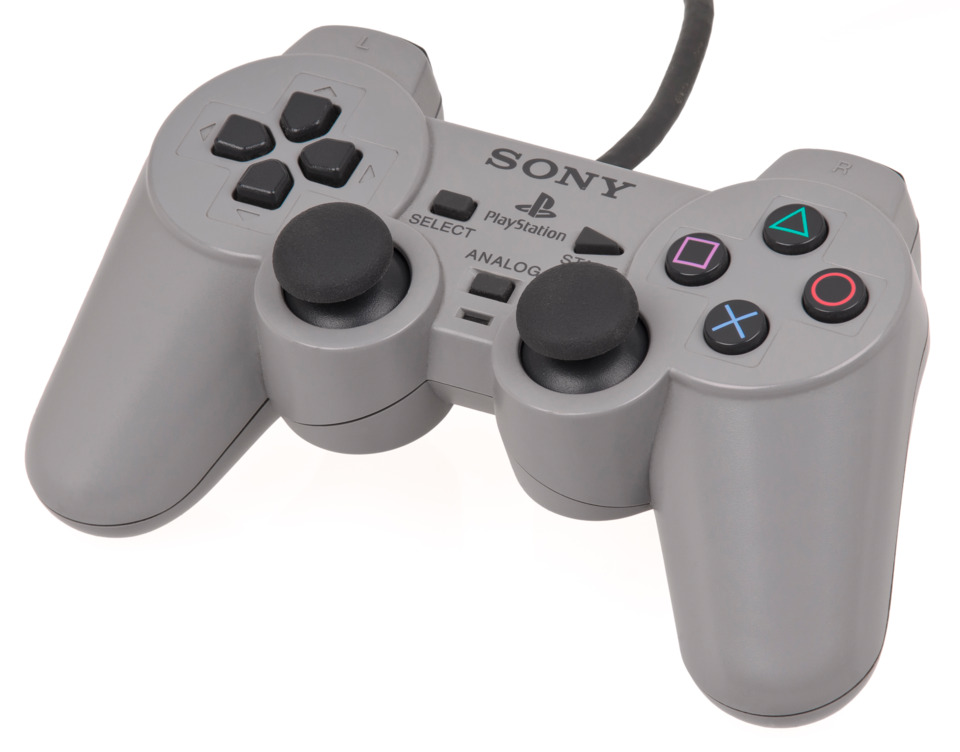
Enhancing Sony’s previous design choices, the DualShock has two convex analogue sticks with rubber grips, as opposed to the smooth plastic concave sticks that came before. It also has different grips and slightly larger L2/R2 buttons. The Flightstick mode was removed from the “Analog” button likely due to its lack of use. On the front of the controller we are face to face with a “if it ain’t broke don’t fix it” design mentality – the sacred symbols are still there, as are the Start and Select buttons.
This controller didn’t ship with a console and seemed to be released for people who wanted more from their PlayStation. The games that were being played were increasingly three dimensional, so having analog sticks to accurately navigate these worlds, instead of relying on the stiffer inputs of the D-Pad, made much more sense. Support for the controller was vast on release. Games like Spyro the Dragon benefited greatly from the analog controls and vibration capability, Capcom re-released Resident Evil with Resident Evil: Director’s Cut to support it, and games like Gran Turismo and Quake II used both motors in stereo to add more presence for players, making them feel more immersive when accelerating in a car or shooting at the baddies. SCE Japan Studios Ape Escape was the first game to require the DualShock, as the game made use of both sticks, otherwise you couldn’t progress past the main menu!
Do you remember the PSone? It was that cool mini PlayStation that was white instead of grey and had that lovely looking mini screen. Well, it had its own unique DualShock controller too! White in colour, it had “PSone” instead of the “PlayStation” logo printed in the centre, a brighter cord and a connector that was circular rather than rectangular. Overall, the PSone seemed like the “ultimate” PlayStation model that Sony intended on being smaller, rounder and looking a lot cooler than its older sibling.
DualShock 2 Analog Controller
The first DualShock to be packaged with a new generation of console (some might even say the best generation), the PlayStation 2 (PS2) is the best selling console of all time, with over 155 million units sold. We can probably deduce that the DualShock 2 has been handled more than any other type of video game controller, just like your mother.
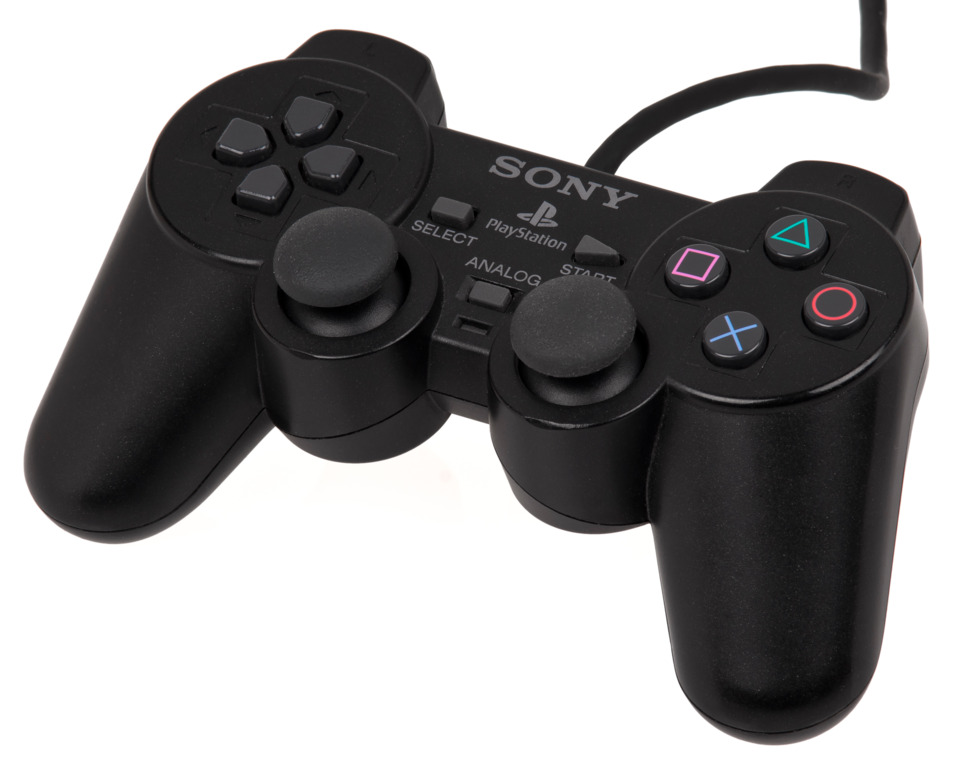
At a glance, the DualShock 2 doesn’t differ that much from the original DualShock. It’s cosmetically different; now a sleek black (in controller and cable) to match the console, instead of the original foghat grey. The blue DualShock 2 logo on the top of the controller affirms that Sony thought it was good enough to give a name and some branding. It was lighter in weight than the original, with slightly stiffer analog sticks,and added pressure sensitive buttons (analog input, if you will) to help further immerse the player (for instance pushing down half way to aim bow and then pushing down fully to fire).
The DualShock 2 was a very popular controller and Sony knew; they released a variety of colours, including crimson red and candy pink. Of course, the thing everyone remembers is the bastardised third party rip offs you’d give to your friends when they came round. The legend tells us of the great legend of Mad Catz which thrived during this era, who can really say what happened to them after!
The era of the PS2 and the DualShock 2 was great for video games. The console was affordable, hosted many great games, and for a lot of people was their first DVD player. It’s a time that people look fondly back on, at least compared to what was about to come…
The Failed Boomerang Controller
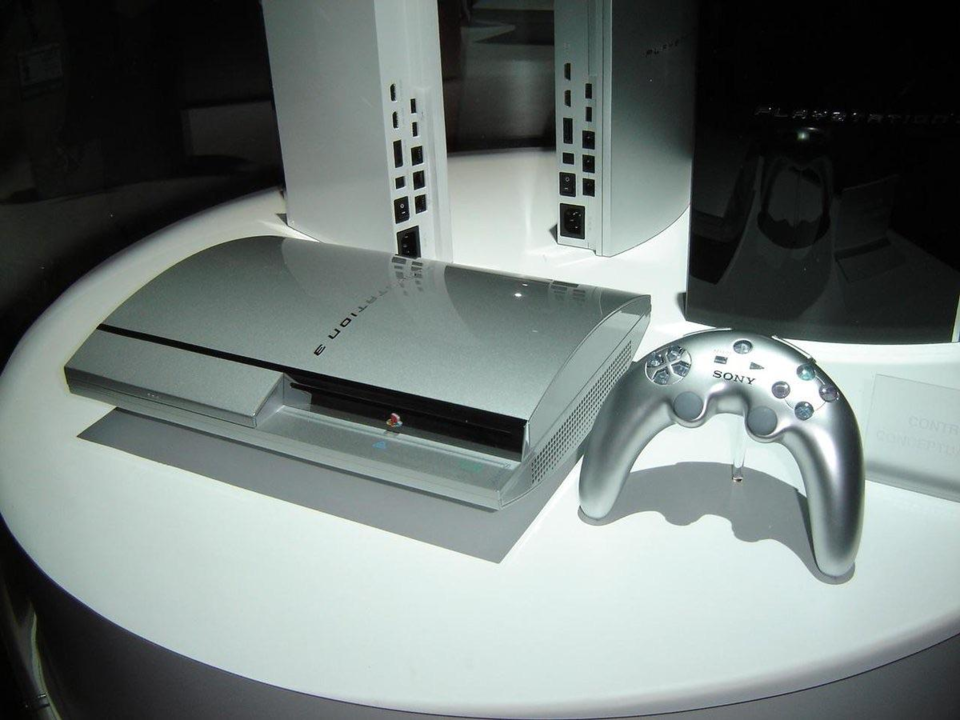
Although never made available to the public, the failed boomerang prototype gives us an insight to what Sony were thinking in 2005. Unveiled at the year’s E3 conference alongside the PlayStation 3 console, Sony quickly abandoned the design after receiving universal negative feedback, stating it was a design concept and was never intended to be the final controller.
While it does have a cool “Minority Report” swagger about it, one has to believe that using the “boomerang” as a primary controller would feel uncomfortable in one’s hands. It’s important to remember this was a time after the Xbox “Duke” controller and its smaller redesign, gamepads were being designed for comfort and the Boomerang design seems everything but.
Sixaxis Wireless Controller
The PlayStation 3 (PS3) era was definitely a rough time for Sony. Announced at an eye-watering release price of $600 (£425 in the UK), to say people were put off by going into the next generation would be an understatement. Sony didn’t help the case by implying people should work more to purchase it. It was released on November 11, 2006 in Japan to those that had a good salary or were able to secure that second job.
After the negative reception of the “conceptual” boomerang controller, the PlayStation team went back to the drawing board. After presumably hundreds of hours of research and development, they once again decided “if ain’t broke, don’t fix it”. Well, cosmetically anyway. Minor differences include the L2 and R2 buttons now being triggers with analog input, and the addition of a “PS Button” in place of the previous Analog button. This is the first controller bundled with the console to have wireless connectivity: on top of the device is a USB Mini-B port accompanied by tiny LEDs which show you which player you are.
Under the hood, the Sixaxis controller has a lot more going on compared to its predecessor; increased precision within the analog sticks, the ability to process analog and digital signals at the same time, Bluetooth connectivity, and a rechargeable battery. Not only that, but it was also the first official Sony PlayStation controller to support motion control in what they called “Sixaxis”.
Named the Sixaxis because of its ability to provide six degrees of freedom, the simplest way to explain it is as such: Translation Movement where a body is free to translate in 3 degrees of freedom: forward/back, up/down, left/right and Rotation Movement where a body can also rotate with 3 degrees of freedom: pitch, yaw, and roll (Taken from: Road to VR). Some critics believed this to be a reactionary move after Nintendo’s announcement of the Wii Remote earlier in the year but Sony were steadfast in their conviction that this was not the case. Fans were also aggravated when it was announced that the Sixaxis technology meant that any previous rumble features wouldn’t be included. At the time there were so many different statements surrounding this mess, with “touch feedback professionals” saying “I don’t believe it’s a very difficult problem to solve” while Sony’s Worldwide Studio President Phil Harrison explained:
“I believe that the Sixaxis controller offers game designers and developers far more opportunity for future innovation than rumble ever did. Now, rumble I think was the last generation feature; it’s not the next-generation feature. I think motion sensitivity is. And we don’t see the need to do that. Having said that, there will be specific game function controllers, potentially like steering wheels that do include vibration or feedback function — not from us but from third parties.” (via Gamesindustry.biz)
It truly was a dark time for Sony fans, having to get a second job to afford your shiny new PlayStation console that looked like a George Foreman grill, one that might not even be able to play your old PS2 games, and had no rumble feature.
One thing is for sure though – that Sixaxis controller was really lightweight. Like seriously.
DualShock 3
Less than a year after the PS3 released with the Sixaxis model, Sony had somehow been able to crack the code on the impossible task of motion control and rumble feedback, announcing the DualShock 3. It was released November 11, 2007 in Japan, and in the following April Sony confirmed it would discontinue the Sixaxis for the DualShock 3 to take its place.
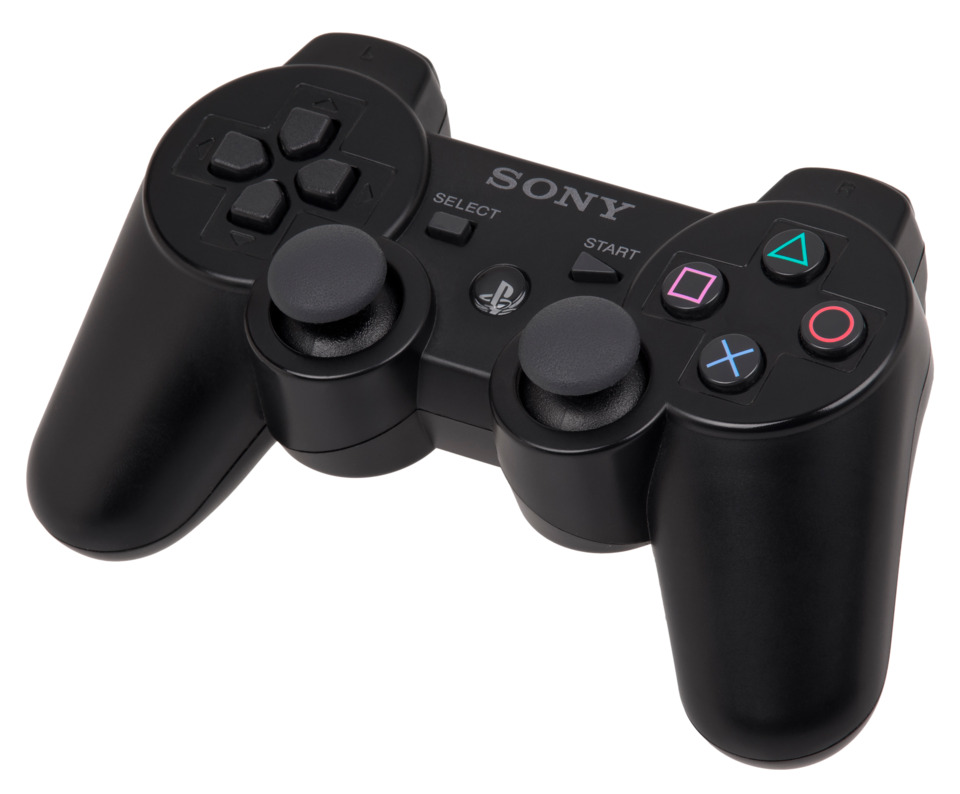
It appeared that the reason the rumble feature wasn’t included in the Sixaxis from the beginning was due to an ongoing legal battle with a touch feedback company called the Immersion Corporation. Once the lawsuit was settled, Sony were happy to put the technology back in the controller. Our old pal Phil Harrison even made a statement, not to apologise for being misleading, but to clarify that he wasn’t actually lying, but defending their stance:
“As to previous statements that I made; we were in a lawsuit—what do you expect me to say? We were in a lawsuit. We were in litigation. Of course I have to defend our view. And actually, I still truly believe that having the Sixaxis controller the way it is is the best way to control games. And I think that we’re looking forward to working with Immersion going forward, and who knows where that is leading us.” (via: Arstechnica.com)
The DualShock 3 is visually identical to it’s Sixaxis counterpart. If you looked at them face on, you’d be hard pressed to know which one is which. The only difference that gives anything away is the weight difference . The DualShock 3 weighs over 50 grams more and has “DualShock 3” and the original “Sixaxis” markings on the top.
The launch of the PS3 saw a bullish Sony that had taken their spot with the number one selling console for granted. They believed that they could create whatever high-end console they wanted and consumers would buy it. This was the generation that humbled Sony, and taught them they shouldn’t rest on their laurels regardless of the hardware they’d created.
DualShock 4
The DualShock 4 saw the biggest change to Sony’s controller design to date. After a generation that saw the publisher having to claw their way back to restoring their huge legacy, they were determined to fire on all cylinders for the PlayStation 4 (PS4) launch. Everything from a more consumer friendly price point, to clear and humorous marketing moves, Sony seemed focused on making this generation theirs (luckily for them, Xbox had a massive hand in helping them). The DualShock 4 was released November 15, 2013 in America alongside the PS4. We’re still waiting for the first brave console manufacturer to release a controller after the console, perhaps the PS6 will grace us with this concept.
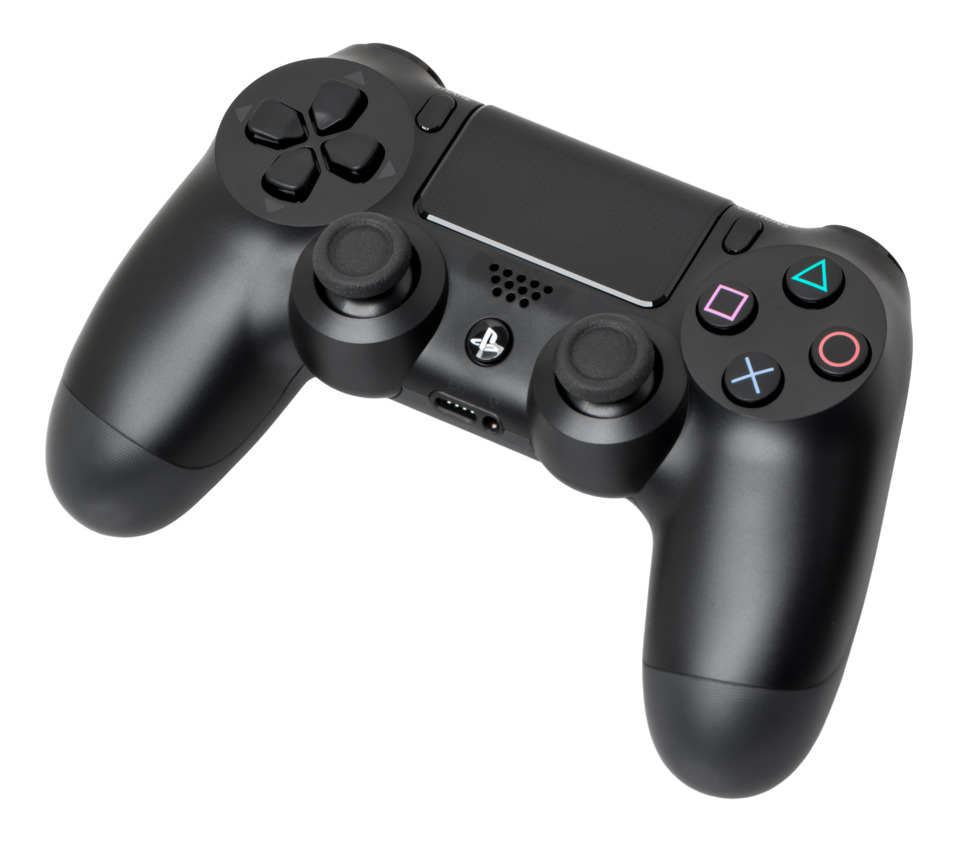
The first noticeable difference with the DualShock 4 is how it seems much more rounded when compared to the older iterations. They’d clearly taken a look at what can make a controller not just ergonomic, but fun too. Through developer input, the team created something that had different analog sticks (concave instead of convex) and shoulder buttons that were sleeker and more rounded when compared to previous generations. There was no flaky concept hardware on show this time round – Sony had a vision for this controller and they were sticking to it.
The touchpad is the biggest new addition (in a visual sense) here. It incorporated two-point capacitive technology, meaning it can pick up the use of two fingers (or points) and can also be pressed down like a traditional button. Different gestures can be enabled to help for quick accessibility, for instance, a swipe up could bring up a skills selection, or clicking on the left side could bring up a map. Gone are the old player indicators at the top of the controller face, now replaced with a lightbar to identify players (e.g Player One is Blue, Player Two is Red, etc). This simple but colourful technology consists of three LEDs illuminating underneath to create different colours. Developers can also use this to further immerse players; playing GTA V in the dark with the police after you will have the whole room illuminated in red and blue for example
Other new additions include a 3.5mm headphone jack, a micro-USB port and a mono speaker. The DualShock 4 also streamlined some buttons, removing the START and SELECT buttons in favour of a more simplistic “Options” and a “Share” button to easily capture/share screenshots and videos of memorable moments. Additionally the only analog buttons on the controller were the shoulders, as it was argued that developers and their games did not take advantage of the “Sacred Symbols” pressure sensitivity.
It wasn’t all sunshine and rainbows though. Some launch DualShock 4’s had wear issues on the sticks. One of the highlights of my own personal retail career was arguing with customers about overused rubbers (in regards to the rubber pads on the analog stick). Sony released the DualShock 4 v2 which had improved battery life, a window in the touchpad to see the lightbar and of course enhanced rubbers.
DualSense
The next generation is almost among us. With the release of the PlayStation 5 (PS5) we are going to be treated to another controller by Sony, and by all accounts this one is a game changer. To show how serious they are about it they’ve dropped the name DualShock in aid of a more artistic name with the DualSense label.
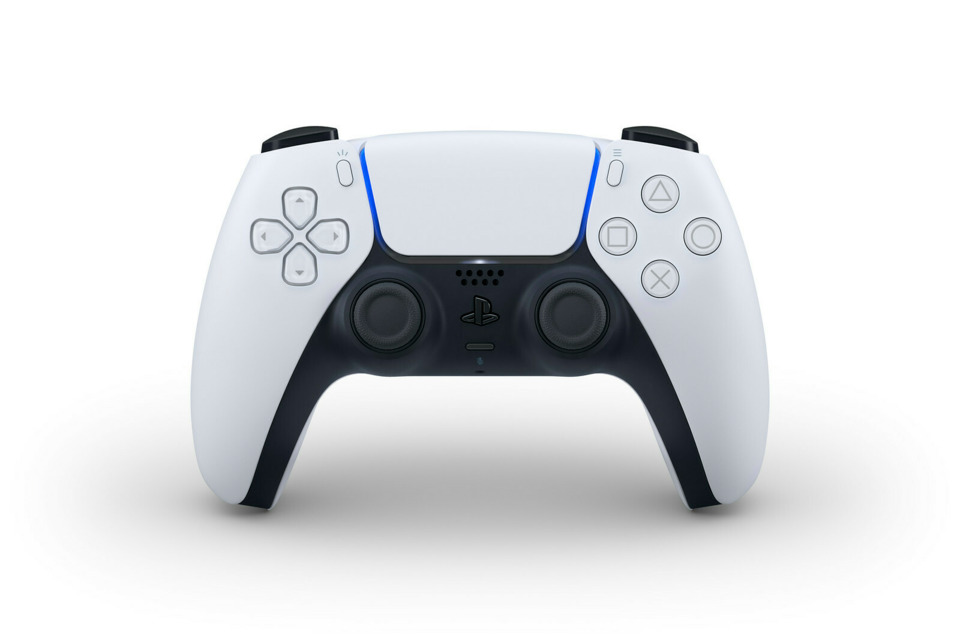
Instead of one solid colour the DualSense is Black & White, and looks like a natural evolution of the DualShock 4. They’ve taken everything that made it great and ratcheted it up to eleven. It’s been tweaked, tightened and enhanced to make it the most complete controller Sony has ever released.
Although it’s yet to be released here in the UK, the new controller has already received high acclaim. Sony have decided to throw all the features they can at the DualSense: Haptic feedback, an improved speaker, a built-in microphone, adaptive triggers that can change resistance, and a higher capacity battery.
Sony have completely refined the controller experience this time round. The lightbar now encapsulates the touchpad. As is now slowly becoming the standard worldwide, there’s a USB-C port for charging. Controversially, Sony has implemented global button functionality, much to the chagrin of Japan, thus breaking a tradition that’s over 20 years old.
The DualSense by all accounts is one of the most unique aspects of the PS5, and the bundled-in game Astro’s Playroom shows just how much technology is packed into this controller.
From the humble beginnings of the original PlayStation, Sony have always adapted to try to enhance player immersion and enjoyment of video games. There certainly have been some missteps along the way, but going with this next generation it seems Sony have finally figured out what makes a truly great controller for everyone.
I originally wrote this for my website and would appreciative of some extra eyes/feedback from the Giantbomb community.
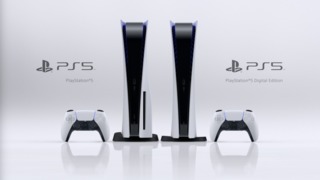
Log in to comment